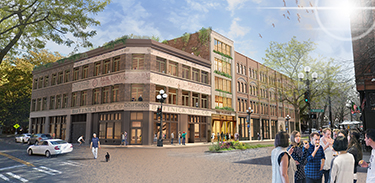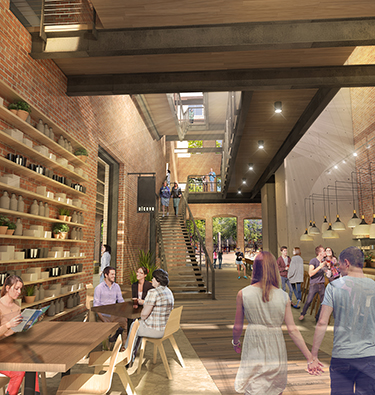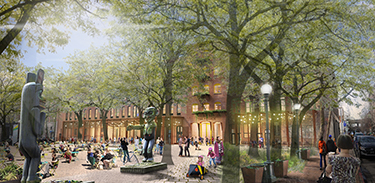|
Subscribe / Renew |
|
|
Contact Us |
|
| ► Subscribe to our Free Weekly Newsletter | |
| home | Welcome, sign in or click here to subscribe. | login |
Architecture & Engineering
| |
June 21, 2017
A look at Unico's plan for turning the Grand Central block into apartments
Journal staff reporter
Unico Properties will brief the Pioneer Square Preservation Board today on its plans to renovate the historic Grand Central block, at 216 First Ave. S. in Pioneer Square, and replace the office space with market rate apartments.
Street-level retail space would be reconfigured, though not expanded, and the east side of the buildings, facing Occidental Park, would be extensively reconfigured, with a new “covered porch.”
Graham Baba Architects is designing the new plan for the three attached buildings: the four-story Grand Central Building with its interior atrium, the five-story City Loan Building and three-story Buttnick Building.
A midblock “Grand Passage” connector, similar to the Grand Central atrium, would be added to the City Loan Building, which would become the hub for all three structures.
The board meeting is set for 9 a.m. at City Hall, 600 Fourth Ave., Room L2-80.
Unico President Jonas Sylvester said, “The viaduct [replacement] is part of the story with what's happening in Pioneer Square. There's a tremendous amount of public investment in Pioneer Square.”
Besides the viaduct, he also cites the coming First Avenue streetcar, Sound Transit 2 and 3, and the revitalization of Union Station and King Street Station.
All of that, he said, “Just serves to reconfirm how much of a hub Pioneer Square is.”
Unico bought the block in 2014 for $26.6 million, and had previously considered renovating the three buildings, which together have about 116,000 square feet. That plan by Akiyama Architects included connecting all the interior floors, but it did not proceed.
Sylvester did not disclose what this renovation might cost, except to say, “It's not for the faint of heart. We're investors who believe in the long-term vision of Pioneer Square.”
Why the shift from offices to apartments? “We thought that residential made greater sense to align with the city's 2020 plan,” said Sylvester. “There have certainly been calls for residential. That's where the need is greatest.”
Unico estimates that about 200 people will eventually reside in the Grand Central block, helping to boost Pioneer Square's 24-7 population. But, said Sylvester, “We haven't got the exact unit count yet.”
No general contractor or structural engineer has been selected.
This part of Pioneer square is zoned to 100 feet and additional floors are being contemplated, but Sylvester said, “We really want to add as little [height] as possible.”
Sylvester declined to put a timeline on the project, but said, “The time to do this is now. But now is not tightly defined.”
Demolition of the Alaskan Way Viaduct is set begin in 2019, after the tunnel opens to traffic. Sylvester says he has that date in mind: “When those things come online, that's when we want to be ready.”
Some interior connections already exist inside the three buildings, so Sylvester said there is no plan to change the floor levels.
“The City Loan building will provide more connection” between First and Occidental Park, he said, and help to activate the park. That grand passage would include an exposed staircase and new shops.
The retail configuration will change to have more and smaller spaces, but the square footage will stay about the same.
Renovation will include full seismic work, new building systems and other measures to bring the block up to code.
Construction would not be phased, and could take over a year, so existing tenants would have to relocate. Tenants include Swannies, The Comedy Underground, Grand Central Bakery, Fireworks Gallery and Arundel Books.
Sylvester said he hopes that some of those tenants will return. “We have a lot of wonderful retailers now.”
In a press release, Unico said it will pursue a combination of environmental design standards including LEED, Living Building Challenge and 2030 Challenge.
Unico said it also wants to seismically retrofit the unreinforced masonry structures to bring them up to code and “protect the buildings from a major catastrophic event.”
Sylvester said that properly maintaining the Grand Central block means improving it. “Those investments aren't being made across Pioneer Square. There have been certain elements of the buildings that have been lost because of underinvestment.” Adding some extra space, likely set back from the roofline, would create a more reasonable return on investment.
The renovation and conversion project would require approval from the preservation board. The change of use from office to housing might also require a master use permit from the city.
It's worth remembering that Unico acquired the Grand Central block in 2014, a year after Bertha began drilling. In fact, Unico bought the property during Bertha's two-year hiatus for repairs. Now that the digging is done, said Sylvester, “I'm very glad that's through.”
Founded in 1953, Unico has more than 23 million square feet of LEED-certified properties in its portfolio. Among its historic properties are Smith Tower and the Cobb Building in Seattle, and the Washington Building in Tacoma. Like the Grand Central block, the Cobb and Washington buildings are office-to-residential conversion projects.
Brian Miller can be
reached by email at brian.miller@djc.com or by phone at (206) 219-6517.





